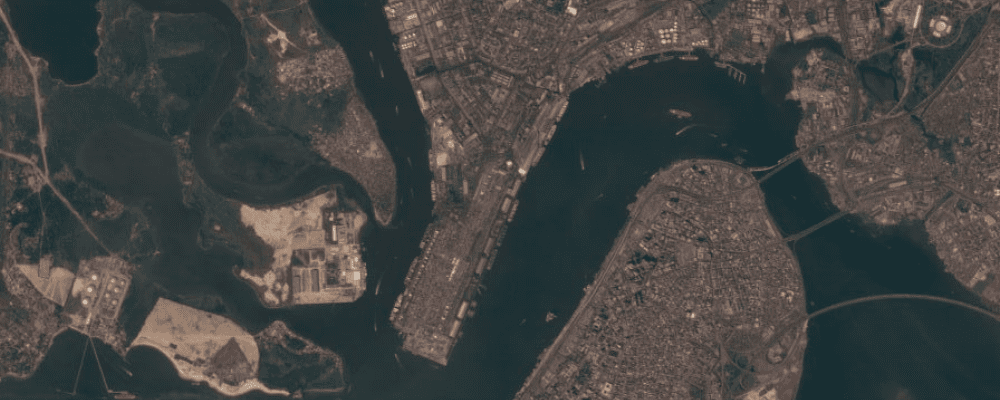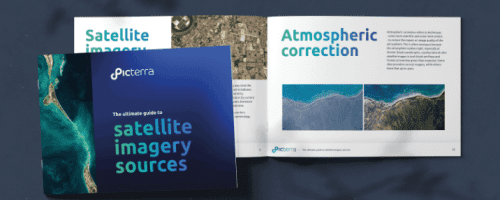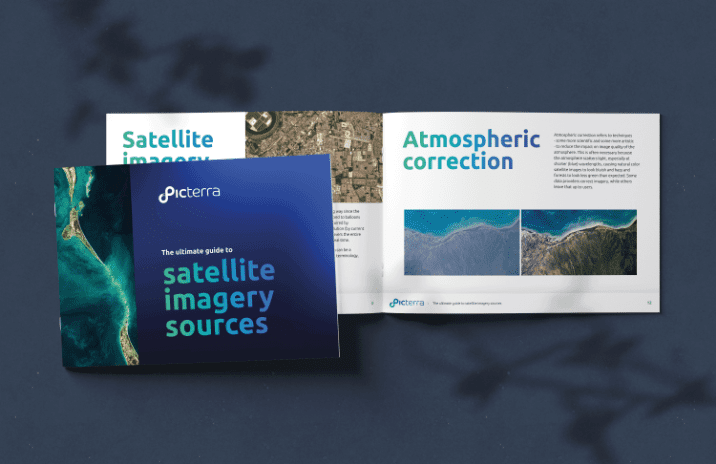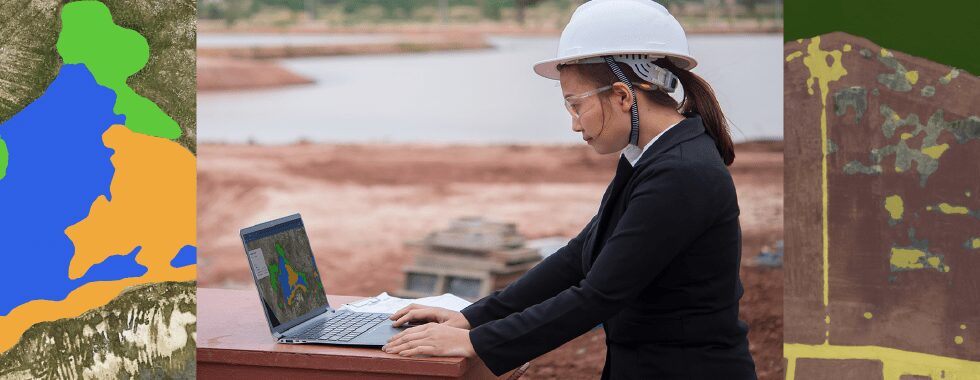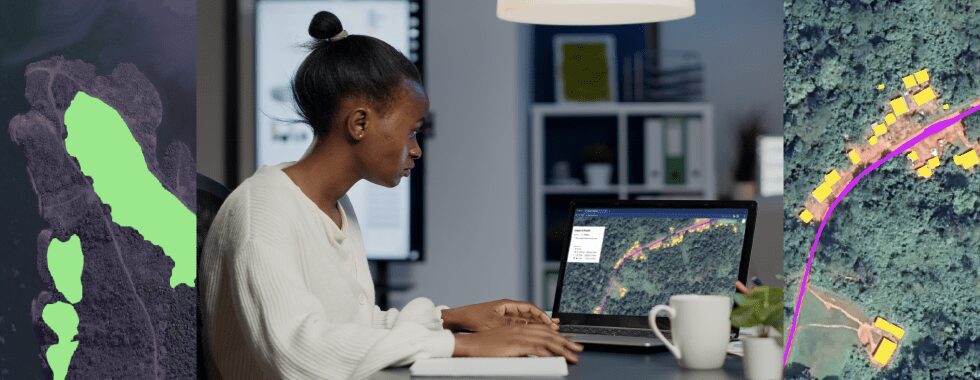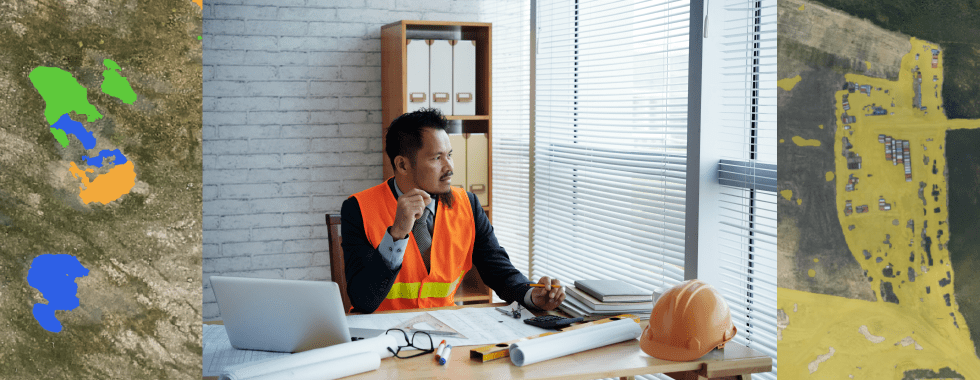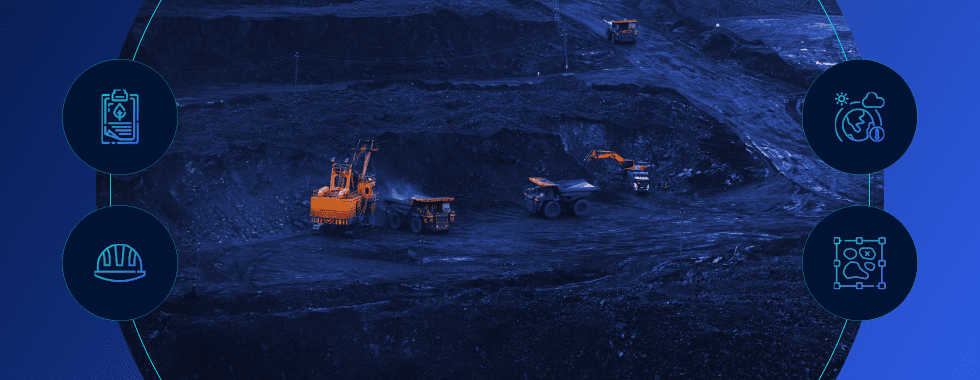Earth observation (EO) technology and satellite imagery sources have come a long way since the 1840s, when some of the first cameras were strapped to balloons and kites. Until a few decades ago, Earth Observation imagery acquired by satellites captured only selected areas at low-resolution (by current standards) mainly for military purposes. Today, it covers the entire planet in high-resolution, on-demand, and in near real-time.
Spaceborne Earth Observation imagery is a prime example of “big data”—which also includes data on cell phone locations, traffic, and consumers’ shopping habits—traditionally managed and analyzed exclusively by specialists. However, the dramatic fall in the cost of cloud storage and cloud computing in the last several years has vastly increased the number of companies using EO data internally and/or analyzing them for external customers, performing such tasks as monitoring crops or counting the number of cars in the parking lots of big box stores.
Much satellite imagery is available for free from public sources and affordable amounts of satellite imagery from commercial sources can be well worth the investment even for medium and small organizations. There are also many public and commercial websites that aggregate satellite imagery and can help you select the sources and types most useful to you, store and manage these data for you, and analyze them to extract the insights that can improve your company’s business or advance your public agency’s goals.
For a growing number of organizations, Earth Observation data has become indispensable. Many more organizations would benefit from satellite imagery but believe that they cannot manage the complex technical issues of acquiring, managing, and using these data, nor afford the cost of doing so. Yet even a small investment in learning about the different kinds of EO imagery, where to acquire it, and how to use it can go a long way. Hopefully, this article can help you get started.
Recent Changes in the EO Marketplace
Several factors in recent years have contributed to rapid changes in both the science of remote sensing and the EO marketplace:
The European Space Agency (ESA), the U.S. National Aeronautics and Space Administration (NASA), and the U.S. Geological Survey (USGS) have all adopted a policy of free and open data, which has driven an exponential growth in downloads of EO data. ESA’s Copernicus program, which launches the Sentinel satellites, is committed to continuity of service through at least 2030.
- In 2014 the U.S. government relaxed its restrictions on commercial sales of high-resolution imagery, allowing providers to sell them at their best native resolution. Maxar and Airbus have been launching multispectral satellites with increasingly better resolution, currently down to 0.3 m.
- In 2019 the U.S. National Reconnaissance Office (NRO), which took over a year earlier from the National Geospatial Intelligence Agency (NGA) the responsibility for buying commercial satellite imagery for the federal government, decided to move beyond the single-supplier arrangement that NGA had signed nearly a decade earlier with DigitalGlobe (recently rebranded as Maxar Technologies by its parent company) and begin buying products from new vendors.
- The collection of EO imagery has dramatically increased due to the proliferation of cubesats and the explosion in the number of unmanned aerial vehicles (UAVs) and will be spurred further by the advent of reusable rockets.
- Cloud computing and machine learning (ML) have vastly increased the capacity and speed to store and analyze this flood of new imagery.
Satellite imagery sources: The Basics
Before starting to download satellite imagery, it is helpful to know a few basic concepts about Earth Observation satellites and the data that they collect. One practical reason is that most download sites will ask you to choose various parameters to narrow your search of all the available imagery.
Orbits
Satellites orbiting Earth at different altitudes provide different perspectives, some always focused on the same area while others are constantly circling our planet. There are essentially three types of Earth orbits:
- low Earth orbit (LEO, 160 km to 2,000 km), which is used by most scientific and commercial satellites,
- medium Earth orbit (MEO, 2,000 km to 35,780 km), which is used by navigation satellites and those designed to monitor a particular region and,
- high Earth orbit (HEO, ≥ 35,780 km), which is used by many weather satellites and some communications ones.
A satellite’s orbital height determines how long it will take to orbit, because its motion is mostly controlled by Earth’s gravity: the lower it is, the stronger the gravitational force on it and, therefore, the greater its speed. One orbit can take from as little as a couple of hours to as much as 24 hours. (Our planet’s natural satellite, the Moon, which is 384,403 kilometers from Earth’s center, completes each orbit in 28 days.) In addition to height, an orbit also has two other parameters: eccentricity, which describes its deviation from a perfect circle, and inclination, which is its angle in relation to Earth’s equator.
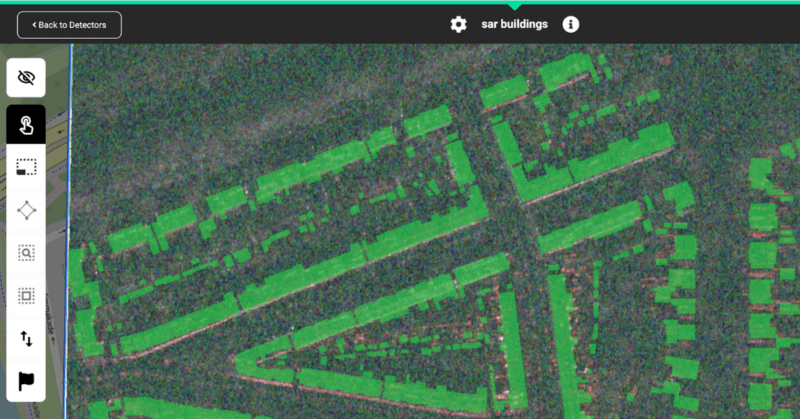
SAR imagery is what many in the geospatial world consider the cutting edge of earth observation imagery and with its ability to see through clouds and in the dark it has massive but yet undiscovered potential, especially for monitoring and alerting applications. Picterra is working to push the bounds of the industry to make this data both more readily available and actionable.
The temporal, spatial, and spectral resolution
Temporal resolution, also known as the revisit time, is the amount of time between satellite passes over the same geographic extent. While for each satellite this depends on its orbit and its capacities to look off-nadir, i.e. on the sides with a certain view angle, most satellites operate as part of a constellation of satellites of the same kind, working together to increase their global daily coverage. For example, Planet’s constellation of 150 mini satellites covers the whole globe every day, while the lone Landsat-8 satellite takes 16 days to do so.
Spatial resolution is directly related to the size of each pixel in an image: the smaller the pixel, the finer the image’s clarity. It ranges currently from 250 m to 0.3 m. (The resolution of classified military EO satellites is higher, 30cm being since 2014 the maximum allowed.) While most imagery with a resolution lower than 10 m is free, imagery at higher resolutions is usually a commercial product. While a 10 m resolution is useless to a realtor wanting to examine a property, it can be superb to a geologist studying a glacier. Panchromatic (see below) imagery always has a much higher resolution than multispectral (see below) imagery.
Spectral resolution refers to the number of radiation bands in the electromagnetic spectrum that a satellite can sample — including microwave, infrared, visible, ultraviolet, and x-ray. While visible light delivers images in natural color, other wavelengths — most commonly near-infrared and short-wave infrared — enable us to see features that would otherwise be hard or even impossible to see, such as burn scars, and thermal bands deliver temperature readings. For example, Sentinel-2 image data contains 13 spectral bands, with a resolution ranging from 10 m to 60 m. Unfortunately, due to technical constraints, satellite remote sensing systems can only offer either a high spatial resolution with a low spectral resolution or a high spectral resolution with a low spatial resolution. The data’s intended application will determine the choice of solution.
Sensors, panchromatic images, multispectral images, orthorectification, pansharpening, and more
We have put together a comprehensive ebook that will help you understand what is the difference between panchromatic vs. multispectral imagery, what can be done with SAR imagery, how the atmospheric correction works, what is an orthorectification, and more. You’ll learn how to use archive imagery and how to task a satellite to monitor areas of interest and detect any changes there.
Want to learn more?
Satellite imagery sources: Where to Start
If you are not already familiar with the world of EO imagery, you might want to start by comparing free Landsat, MODIS, and Sentinel imagery with sample high-resolution imagery from Maxar. Landsat, a joint program between NASA and the U.S. Geological Survey (USGS) that has been in existence for more than 40 years, provides the longest available continuous space-based record of Earth’s land. It images Earth once every 16 days. The latest satellite in the mission, Landsat-8, was launched in 2013, and is currently the second highest resolution available for free for optical data. NASA’s MODIS constellation images Earth every one to two days and the Sentinel satellites, operated by the European Space Agency (ESA), do so every two to three days. Maxar owns and operates the WorldView-1, WorldView-2, WorldView-3, and GeoEye-1 satellites. They all have sub-meter resolution; WorldView-3 has a resolution of 0.3 m, which is the best commercially available.
Next, you will need to determine which factors matter the most for your intended use of EO imagery. Obviously, you need a source that has coverage of your area(s) of interest (AOI). Beyond that, you will need to be able to answer the following questions:
- What spatial resolution do you need?
- Is natural color (which measures the visible spectrum) fine for your purposes or do you need other spectral bands to reveal features or phenomena otherwise invisible?
- Will you be content with downloading imagery already processed by the provider or will you need to access the raw image files?
- How frequently will you need to have a fresh look at your AOI?
- What is your budget?
- Will you need the right to sell the imagery or use it in any other commercial way?
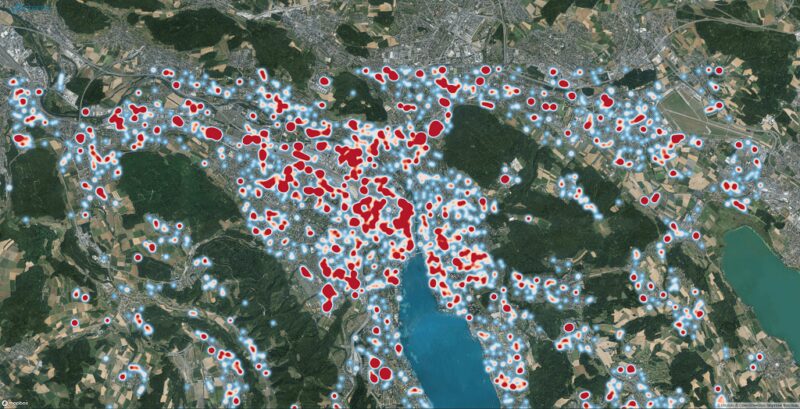
A heatmap showing solar panels detected over Zurich, Switzerland
Here are a few important considerations:
- Free satellite data is typically at low resolution (you can detect buildings but not cars) or dated (from a couple of months to a couple of years), while near real-time satellite data at high resolution is usually available for free only for humanitarian reasons, such as through Maxar’s Open Data program.
- Real-time, high-resolution data is still only a Hollywood fiction and near real-time high-resolution data still takes, in most cases, a few days. However, due to recent advances in automating the capture and distribution of EO data—such as in-flight pre-processing, cloud storage, and automatic ordering—the lag between scene capture and data transfer may soon drop to minutes.
- The imagery you see on Google Earth at the highest zoom level is aerial photography, not satellite imagery.
- Obtaining pricing information requires lengthy conversations—and, often, negotiations—with a sales representative.
How can satellite imagery help your business?
All of the abovementioned rapid changes in the satellite marketplace made it possible to open entirely new business opportunities. Earth Observation data is widely used in crucial industries, including transportation, civil engineering, finance & insurance, real estate, energy, land administration and mapping, agriculture, humanitarian aid, and more. Check our Industry Pages for real-life examples.
At the same time, it is important to know that accessing data and extracting actionable insights from it, typically requires a lot of time and expensive data science resources. Luckily, there are products that aim for democratizing access to geospatial data and insights, and Picterra is one of them. Picterra is a self-service SaaS platform allowing anyone to create, train, and run detectors on satellite and aerial imagery. It has an optimized human-machine interaction, access to imagery, and a large library of pre-trained detectors, without large upfront costs. We facilitate access to open-source satellite data (check our Imagery page for more details) but also high-resolution commercial satellite sources thanks to our partnership with SkyWatch.
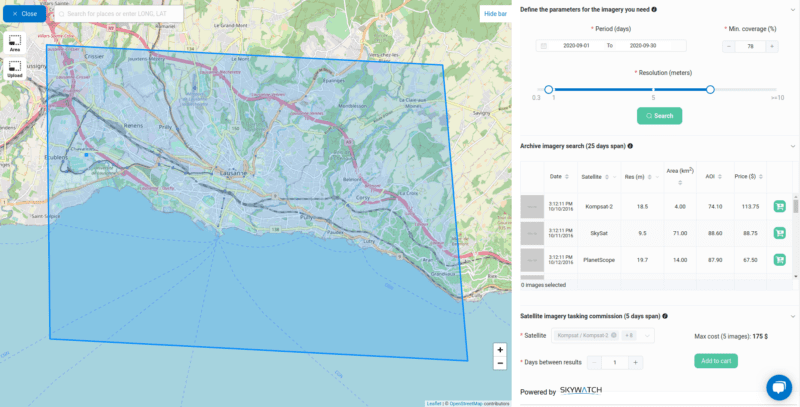
Picterra lets you order archive satellite imagery and task a satellite for monitoring purposes without leaving the platform.
One of the things that has been very difficult to achieve is this ability to easily and affordably access satellite data in a way that is fast but also in a way in which you can derive the insights you need for your particular business, James Slifierz, SkyWatch CEO told SpaceNews. What if you can merge both the accessibility of this data with an ease of developing and applying intelligence to the data so that any company in the world could have the tools to derive insights?
How to stay updated about satellite imagery sources?
- Download our ebook. It’s a 30-page comprehensive guide to Earth Observation imagery that comes together with a handy up-to-date table.
- Access an open-source list of satellite imagery sources from the Geoawesomeness community.
- The Newcomers Earth Observation Guide from ESA.
- The Picterra blog! We’ll soon publish more articles that will help you navigate in the Geospatial world.
